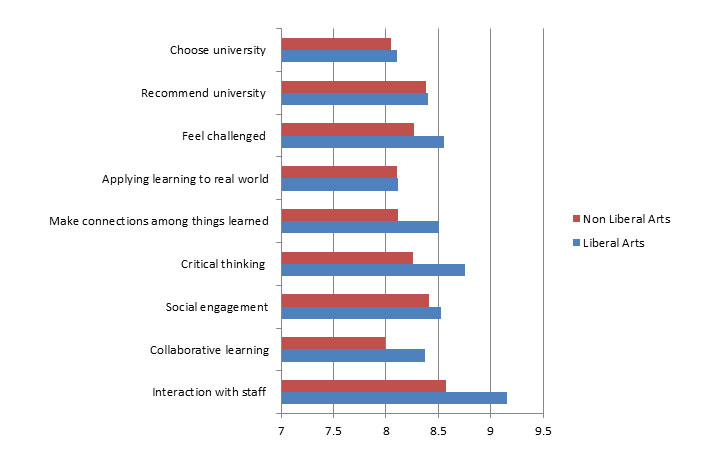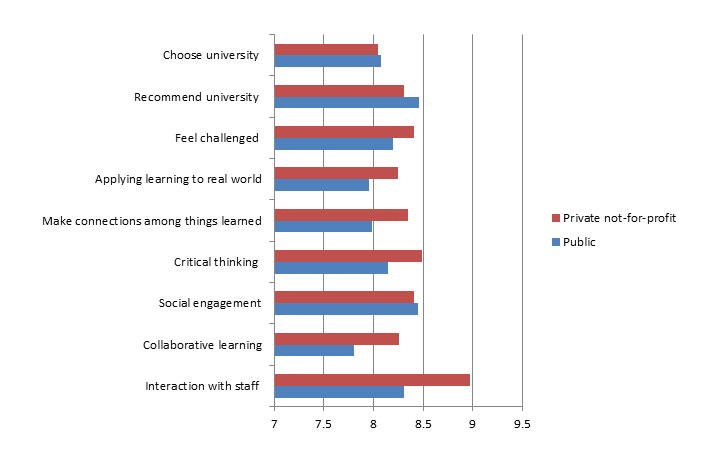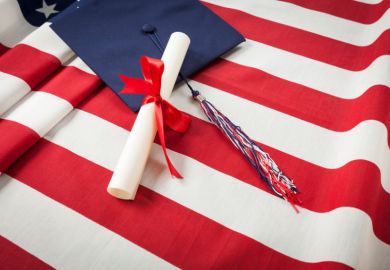It is a long-held belief that liberal arts education, characterised by a focus on undergraduate teaching, multidisciplinary study, low numbers of students and small class sizes, can provide a better student experience than other types of universities, and this view has now been backed up by a Times Higher Education survey of 100,000 students at US universities.
Liberal arts students are generally more satisfied with the teaching at their institution, with students in this cohort more likely to say that they feel challenged, that there are plenty of opportunities for collaborative learning with other students and interaction with staff, and that their university fully supports critical thinking and reflecting upon, or making connections among, things they have learned, according to the study.
These students are also more satisfied with extracurricular activities, reporting that there are plenty of opportunities for social engagement, such as joining student clubs or societies, organising social events and activities on campus and interacting with people in different courses or from different backgrounds.
Students at liberal arts colleges in the US are also slightly more likely to recommend their university to a friend and choose to go to their college again than students at other types of higher education institutions, the survey found.
Student engagement at liberal arts and non-liberal arts colleges

For each of the survey questions, students were asked to rate their university on a scale of one to 10, where zero represented no support and 10 represented being fully supported. When asked whether there are opportunities to interact with staff, for example, liberal arts students gave an average score of 9.16, while non-liberal arts students gave an average score of 8.57.
The strength of liberal arts colleges when it comes to the student experience is a key finding from THE’s inaugural US Student Survey, which will form a major part of the methodology of a new THE and Wall Street Journal ranking of more than 1,000 US universities and colleges, published next week. The survey was conducted online; respondents were recruited by research firm, Streetbees.
The Wall Street Journal/Times Higher Education College Ranking will also include student-focused metrics such as tuition fee debt, graduation rates and the diversity of campus communities, alongside academic indicators including reputation and research productivity.
Of the 100,000 students surveyed, 12,058 were at liberal arts colleges, of which 10,711 were private not-for-profit institutions. In total, 48,436 students were at private not-for-profit institutions and 46,708 were at public universities.
Adam Falk, president of Williams College, a private not-for-profit liberal arts college in Massachusetts, said there are just seven students to each faculty member at the institution, which allows “really close interaction between faculty and students”.
“Very high graduation rates and the reputation of the college really come from the simple thing of hiring great faculty and giving students lots of access to them,” he said.
Student engagement at public and private universities

However, while liberal arts students generally reported a better university experience, there is a mismatch between private and public liberal arts colleges. When the two are separated, private not-for-profit liberal arts colleges outperform other private non-profit universities, but non-liberal arts public universities outperform their liberal arts equivalents.
The survey also shows that students at public universities rate their institution lower on nearly all areas of student experience than those at private universities, from interaction with faculty and critical thinking skills to making connections among things learned and applying their learning to the real world.
Philip Altbach, research professor and founding director of the Center for International Higher Education at Boston College, said private universities tend to be smaller, spend more money per student and are highly tuition-dependent, meaning that “their survival depends on” attracting the best students.
“The publics have to worry about so many [other] things and, in many cases, they’re quite large [meaning] that they don’t have the resources to put into the student experience issues,” he said.
International students less satisfied than domestic counterparts
International students at US universities are less satisfied than domestic students on all aspects of their college experience; they are less likely to think they could apply their learning to the real world and make connections among things learned, less likely to feel challenged or able to learn critical thinking skills, and less likely to feel that there are plenty of opportunities to interact with staff.
Students from abroad also feel that there are fewer opportunities for socialising with other students and fewer opportunities for collaborative learning, such as group assignments, fieldwork with other students and presenting work to classmates, than domestic students.
The result is that international students are less likely than their domestic counterparts to recommend their university (international students score 8.01 on this measure, compared with 8.41 for domestic students) or choose their university again (7.63 versus 8.11), which is likely to be a significant blow for US universities that are increasingly looking to attract students from abroad.
Among US students, out-of-state students are generally more satisfied than in-state students. Almost two-thirds of the students surveyed were in-state students (63,173), while 28,467 were out-of-state and 3,504 were international.
Editor’s note: 16 June 2017
The information on this page was correct at the time of publication. Since then, Times Higher Education has reissued the US College Rankings. For the most up-to-date 2017 US College Rankings results, always use the overall league table. Click here for more information.
POSTSCRIPT:
Print headline: US liberal arts colleges ‘best for teaching satisfaction’
Register to continue
Why register?
- Registration is free and only takes a moment
- Once registered, you can read 3 articles a month
- Sign up for our newsletter
Subscribe
Or subscribe for unlimited access to:
- Unlimited access to news, views, insights & reviews
- Digital editions
- Digital access to THE’s university and college rankings analysis
Already registered or a current subscriber?







